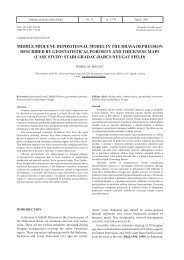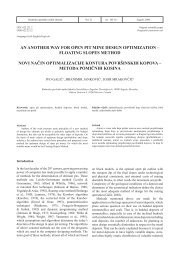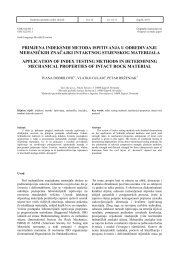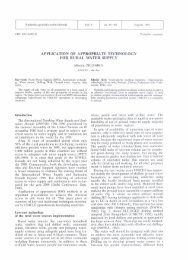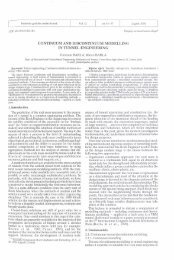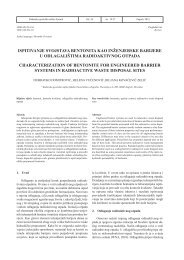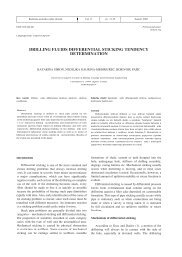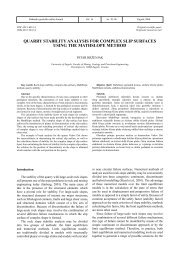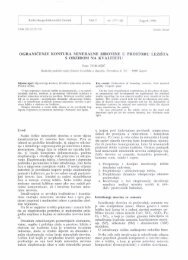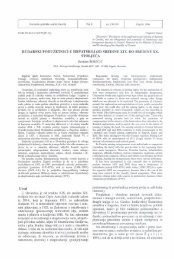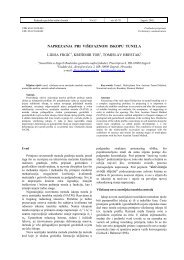management of tunnels on the zagreb – macelj motorway ... - Index of
management of tunnels on the zagreb – macelj motorway ... - Index of
management of tunnels on the zagreb – macelj motorway ... - Index of
You also want an ePaper? Increase the reach of your titles
YUMPU automatically turns print PDFs into web optimized ePapers that Google loves.
84Operati<strong>on</strong> <str<strong>on</strong>g>of</str<strong>on</strong>g> a tunnel requires, first and foremost, asystematic approach to undisturbed and safe traffic flowthrough <strong>the</strong> <str<strong>on</strong>g>tunnels</str<strong>on</strong>g>, which makes it necessary to optimizeall <strong>the</strong> parameters <str<strong>on</strong>g>of</str<strong>on</strong>g> <strong>the</strong> tunnel as a whole, rangingfrom tunnel equipment systems, through maintenance andm<strong>on</strong>itoring <str<strong>on</strong>g>of</str<strong>on</strong>g> tunnel structure, to <strong>the</strong> readiness to act incase <str<strong>on</strong>g>of</str<strong>on</strong>g> undesirable events.In case <str<strong>on</strong>g>of</str<strong>on</strong>g> <strong>the</strong> traffic safety, operati<strong>on</strong> <str<strong>on</strong>g>of</str<strong>on</strong>g> <str<strong>on</strong>g>tunnels</str<strong>on</strong>g> includefollowing basic factors: tunnel infrastructure (passivesafety measures), tunnel Operator (active safetymeasures), tunnel users, tunnel traffic structure and trafficvolume. Tunnel infrastructure or passive safety measuresmean tunnel structural features as well as tunnel equipmentsystems features. Tunnel structural features understandsnumber <str<strong>on</strong>g>of</str<strong>on</strong>g> tunnel tubes, geometry <str<strong>on</strong>g>of</str<strong>on</strong>g> tunnel, liningtype, escape gallery, cross passages numbers, drainagetypes, rock mass characteristics, excavati<strong>on</strong> method andsupport type etc. Tunnel equipment systems features includesinstalled equipment systems such as: tunnel lighting;tunnel ventilati<strong>on</strong> and CO, wind speed and visibilitydevices; fire detecti<strong>on</strong> system; traffic <str<strong>on</strong>g>management</str<strong>on</strong>g> system;tunnel SOS ph<strong>on</strong>es; public address loudspeaker; radio diffusi<strong>on</strong>system; CCTV (AID based) c<strong>on</strong>trol and supervisi<strong>on</strong>system (SCADA); tunnel UPS devices; water supplyand hydrant network system etc. The functi<strong>on</strong> <str<strong>on</strong>g>of</str<strong>on</strong>g> installedequipment is to improve road safety, while ensuring timelyand high-quality informati<strong>on</strong> for users and employeesregarding <strong>the</strong> c<strong>on</strong>diti<strong>on</strong>s <strong>on</strong> <strong>the</strong> <strong>motorway</strong>. Active safetymeasures represent operator’s procedures, implementati<strong>on</strong><str<strong>on</strong>g>of</str<strong>on</strong>g> this procedures, cooperati<strong>on</strong> and communicati<strong>on</strong>with emergency services, and maintenance <str<strong>on</strong>g>of</str<strong>on</strong>g> tunnel infrastructure.Operator’s procedures c<strong>on</strong>sisted standard operatingprocedures and emergency procedures. Standardoperating procedures are used for coordinati<strong>on</strong>, analysesand passing <strong>on</strong> <strong>the</strong> informati<strong>on</strong> ga<strong>the</strong>red from <strong>the</strong> varioustunnel equipment systems helping <strong>the</strong> Operator to make<strong>the</strong> right decisi<strong>on</strong>s in operati<strong>on</strong>al process.In standard operating procedures are defined activitiesneeded to be performed when operator is reporting malfuncti<strong>on</strong>and rectificati<strong>on</strong> <str<strong>on</strong>g>of</str<strong>on</strong>g> equipment. In order to ensurenormal and reliable operability <str<strong>on</strong>g>of</str<strong>on</strong>g> all tunnel systemswith minimum disturbance <str<strong>on</strong>g>of</str<strong>on</strong>g> <strong>the</strong> traffic, to protect dataintegrity and to reduce n<strong>on</strong> availability <str<strong>on</strong>g>of</str<strong>on</strong>g> <strong>the</strong> equipmentto minimum. As comp<strong>on</strong>ent (Pili, 2008) to Standard operatingprocedure with defect report and maintenance resp<strong>on</strong>seis Disaster Recovery procedure ensuring businessc<strong>on</strong>tingency <str<strong>on</strong>g>of</str<strong>on</strong>g> Zagreb <strong>–</strong> Macelj <strong>motorway</strong>.Emergency procedures are used for emergency casessuch as <strong>the</strong> accidents or undesirable events that representa serious interrupti<strong>on</strong> <str<strong>on</strong>g>of</str<strong>on</strong>g> traffic safety. Such cases requirequick implementati<strong>on</strong> <str<strong>on</strong>g>of</str<strong>on</strong>g> temporary measures or usage<str<strong>on</strong>g>of</str<strong>on</strong>g> resources until <strong>the</strong> end <str<strong>on</strong>g>of</str<strong>on</strong>g> <strong>the</strong> accident or interrupti<strong>on</strong>.In accordance with <strong>the</strong> bylaw, <strong>the</strong> Operator has <strong>the</strong> dutyto organize fire fighting duty, and fire fighting drills haveto be c<strong>on</strong>ducted in order to ensure <strong>the</strong> readiness <str<strong>on</strong>g>of</str<strong>on</strong>g> staffmembers and <strong>the</strong> functi<strong>on</strong>ality <str<strong>on</strong>g>of</str<strong>on</strong>g> <strong>the</strong> system in case <str<strong>on</strong>g>of</str<strong>on</strong>g>possible unwanted events. In <strong>the</strong> course <str<strong>on</strong>g>of</str<strong>on</strong>g> <strong>on</strong>e year, fiveRud.-geol.-naft. zb., Vol. 25, 2012.Z. Deković, I. Pili: Management <str<strong>on</strong>g>of</str<strong>on</strong>g> <str<strong>on</strong>g>tunnels</str<strong>on</strong>g>...“dry” drills are c<strong>on</strong>ducted (which includes checking <strong>the</strong>readiness to start <strong>the</strong> interventi<strong>on</strong> at <strong>the</strong> required speed,under full fire fighting equipment), as well as <strong>on</strong>e “wet”drill (where <strong>the</strong> simulati<strong>on</strong> includes unwanted events, toge<strong>the</strong>rwith <strong>the</strong> c<strong>on</strong>sequences <str<strong>on</strong>g>of</str<strong>on</strong>g> fire). Wet drills are c<strong>on</strong>ductedin <strong>the</strong> l<strong>on</strong>gest <str<strong>on</strong>g>tunnels</str<strong>on</strong>g>, Sv. Tri Kralja tunnel and/or Brezovica tunnel, both <str<strong>on</strong>g>of</str<strong>on</strong>g> which are <str<strong>on</strong>g>tunnels</str<strong>on</strong>g> with twowaytraffic. Each year, a different script <str<strong>on</strong>g>of</str<strong>on</strong>g> an accidentis prepared, and all <strong>the</strong> relevant services (Service 112;<strong>the</strong> police; emergency health service; public fire fightingunit; etc.) are included in <strong>the</strong> wet drill. Fur<strong>the</strong>rmore,when it comes to <str<strong>on</strong>g>tunnels</str<strong>on</strong>g> with two-way traffic, <strong>the</strong>re is anincreased level <str<strong>on</strong>g>of</str<strong>on</strong>g> maintenance <str<strong>on</strong>g>of</str<strong>on</strong>g> systems directly c<strong>on</strong>nectedwith fire protecti<strong>on</strong>, which is logical given <strong>the</strong> flow<str<strong>on</strong>g>of</str<strong>on</strong>g> activities aimed at <strong>the</strong> preventi<strong>on</strong> <str<strong>on</strong>g>of</str<strong>on</strong>g> unwanted events.The Operator is tackling <strong>the</strong> <str<strong>on</strong>g>tunnels</str<strong>on</strong>g> with two-way trafficwith even more attenti<strong>on</strong> than usual, precisely because <str<strong>on</strong>g>of</str<strong>on</strong>g><strong>the</strong> increased risk <str<strong>on</strong>g>of</str<strong>on</strong>g> unwanted events taking place.Maintenance <str<strong>on</strong>g>of</str<strong>on</strong>g> tunnel infrastructure represents <strong>on</strong>e <str<strong>on</strong>g>of</str<strong>on</strong>g><strong>the</strong> operati<strong>on</strong>al tools in <str<strong>on</strong>g>tunnels</str<strong>on</strong>g> operati<strong>on</strong>. It is carried outin accordance maintenance manual, requirements, bylawthat is included and amplified in operati<strong>on</strong> and maintenanceprocedures.Tunnel maintenance works can be divided into maintenanceworks <strong>on</strong> a tunnel as a structure <strong>on</strong> <strong>the</strong> <strong>on</strong>e hand,and, <strong>on</strong> <strong>the</strong> o<strong>the</strong>r hand, <strong>the</strong>re are <strong>the</strong> maintenance works<strong>on</strong> <strong>the</strong> tunnel equipment system. Maintenance works <strong>on</strong><str<strong>on</strong>g>tunnels</str<strong>on</strong>g> as structures include <strong>the</strong> following: tunnel inspecti<strong>on</strong>;tunnel cleaning; and c<strong>on</strong>structi<strong>on</strong> maintenance <str<strong>on</strong>g>of</str<strong>on</strong>g><strong>the</strong> tunnel. Tunnel inspecti<strong>on</strong>s can be periodical (e.g. seas<strong>on</strong>alinspecti<strong>on</strong>s and yearly inspecti<strong>on</strong>s), and <strong>the</strong>re arealso general tunnel inspecti<strong>on</strong>s, as well as extraordinaryinspecti<strong>on</strong>s. Periodical inspecti<strong>on</strong>s include <strong>the</strong> visual inspecti<strong>on</strong><str<strong>on</strong>g>of</str<strong>on</strong>g> <strong>the</strong> tunnel. Seas<strong>on</strong>al inspecti<strong>on</strong>s are performedafter <strong>the</strong> winter and summer periods (prior to and after<strong>the</strong> tourist seas<strong>on</strong>), and <strong>the</strong>y are undertaken in order toevaluate traffic safety and effectiveness <str<strong>on</strong>g>of</str<strong>on</strong>g> tunnel equipment,with <strong>the</strong> aim <str<strong>on</strong>g>of</str<strong>on</strong>g> recognizing certain characteristicsthat might point to damage. Annual inspecti<strong>on</strong> is c<strong>on</strong>ductedat least <strong>on</strong>ce every two years, in order to estimate<strong>the</strong> tunnel c<strong>on</strong>diti<strong>on</strong>, and to evaluate possible damage thattunnel elements might be exposed to. There is also <strong>the</strong>need to evaluate safety and usability <str<strong>on</strong>g>of</str<strong>on</strong>g> <strong>the</strong> tunnel in <strong>the</strong>coming period, until <strong>the</strong> next annual inspecti<strong>on</strong>. Generalinspecti<strong>on</strong> (Mlinarević, 2007) <str<strong>on</strong>g>of</str<strong>on</strong>g> tunnel as a structure isc<strong>on</strong>ducted at least <strong>on</strong>ce every six years. It includes a detailedinspecti<strong>on</strong> <str<strong>on</strong>g>of</str<strong>on</strong>g> <strong>the</strong> tunnel as structure, which is a taskperformed by <strong>the</strong> trained staff members <str<strong>on</strong>g>of</str<strong>on</strong>g> <strong>the</strong> Operator,toge<strong>the</strong>r with a specialized external expert company. Tunnelinspecti<strong>on</strong>s provide insight into possible damage andshortcomings <str<strong>on</strong>g>of</str<strong>on</strong>g> a tunnel, in terms <str<strong>on</strong>g>of</str<strong>on</strong>g> its structure stability,traffic safety, and <strong>the</strong> durability <str<strong>on</strong>g>of</str<strong>on</strong>g> tunnel structure.When it comes to tunnel cleaning, it includes cleaning<str<strong>on</strong>g>of</str<strong>on</strong>g> all <strong>the</strong> elements <str<strong>on</strong>g>of</str<strong>on</strong>g> <strong>the</strong> tunnel drainage system; cleaning<str<strong>on</strong>g>of</str<strong>on</strong>g> tunnel walls and tunnel equipment, accompaniedby tunnel washing. The cleaning <str<strong>on</strong>g>of</str<strong>on</strong>g> <strong>the</strong> tunnel drainagesystem is c<strong>on</strong>ducted periodically, with prior inspecti<strong>on</strong>s



